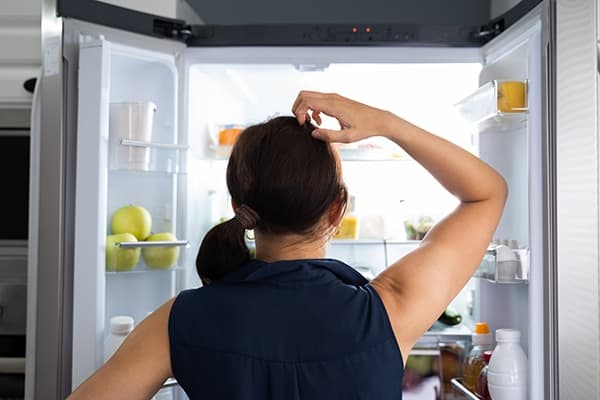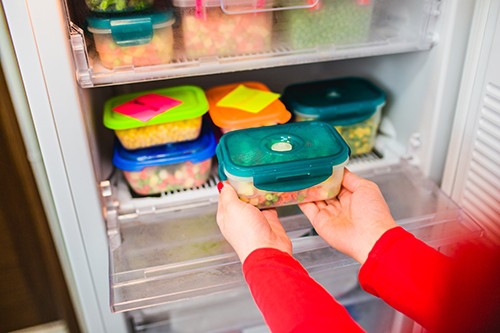If you’re facing the issue of Whirlpool fridge not cooling but freezer works, it could be due to blocked vents, a faulty fan, or thermostat issues. Identifying the cause can help determine whether a simple fix or professional repair is needed.

Let’s take a look at the common causes of this problem, what you can do to fix it, and when it’s time to call a technician.
Possible Causes of a Whirlpool Fridge Not Cooling But Freezer Works
When your Whirlpool fridge stops cooling, but the freezer works as expected, the issue typically lies in the cooling system. Here are some of the most common reasons why this might happen:
1. Dirty Condenser Coils
Condenser coils are responsible for releasing heat from the fridge. If these coils become dirty or covered in dust, they can’t perform properly, which could lead to a temperature imbalance. A dirty condenser coil can prevent the fridge from cooling down, even though the freezer is still functioning.
2. Faulty Evaporator Fan Motor
The evaporator fan is responsible for circulating cold air throughout the refrigerator. If the fan motor is malfunctioning, it can cause the fridge to stop cooling while leaving the freezer unaffected. A faulty motor won’t distribute the cold air properly, leading to cooling issues in the refrigerator section.
3. Damaged Thermistor or Temperature Control Board
The thermistor monitors the temperature inside the fridge and sends this information to the control board. If the thermistor is faulty or damaged, it might send incorrect signals to the control board, causing the fridge not to cool properly. A malfunctioning temperature control board can also prevent the refrigerator from cooling as intended.
4. Air Damper Control Malfunction
The air damper control regulates the airflow between the freezer and refrigerator. If the damper is stuck or broken, the cold air from the freezer won’t circulate into the fridge, causing cooling issues. While the freezer might still work because it’s isolated from the fridge’s air supply, the refrigerator section may not cool properly.
5. Low Refrigerant Levels
Low refrigerant levels can significantly impact the cooling performance of your Whirlpool fridge. If there’s a refrigerant leak or the levels are too low, the fridge won’t be able to cool, though the freezer might still function because it uses a different part of the system. This issue requires professional attention to repair and recharge the refrigerant.
Is It Safe to Use a Whirlpool Fridge That Isn’t Cooling?
If your Whirlpool fridge is not cooling but the freezer is still working, it’s important to stop using the fridge until the issue is resolved. A malfunctioning fridge can lead to spoiled food, higher energy bills, and potential damage to other parts of the appliance. Here’s why it’s best to act fast:
Risks of Using a Fridge That Isn’t Cooling
- Spoiled Food: The fridge is designed to keep food at a safe temperature. When it’s not cooling, perishable items like dairy, meat, and vegetables can spoil rapidly, posing a health risk.
- Increased Energy Consumption: A fridge that’s not cooling properly may use more energy as it tries to compensate for the temperature imbalance. This could lead to higher electricity bills.
- Potential Further Damage: Ignoring the issue for too long can lead to other components of the fridge failing, which may result in a more expensive repair.
Troubleshooting Your Whirlpool Fridge
Before calling a repair technician, try these troubleshooting steps to identify the cause of the cooling issue.
1. Check the Condenser Coils
The first thing you should do is check the condenser coils. These are typically located at the back or beneath the fridge. If they’re dirty or clogged with dust, it can prevent the fridge from cooling properly. Use a coil brush or vacuum to clean the coils, and ensure there is adequate airflow around them.
2. Test the Evaporator Fan
To test the evaporator fan, listen for any sounds of it running. If you don’t hear the fan, it could be broken. You may need to replace the motor or fan blades if they are damaged.
3. Inspect the Thermistor and Temperature Control Board
Check the thermistor to ensure it’s working correctly. If it’s faulty, it might need to be replaced. Similarly, inspect the temperature control board for any signs of wear or damage. If the board is faulty, you may need to replace it to restore proper function to your fridge.
4. Check the Air Damper Control
Look for any obstructions around the air damper control. Ensure that it’s not stuck and is allowing the proper flow of cold air into the refrigerator. If the damper is broken, it will need to be replaced.
5. Examine the Refrigerant System
If you suspect low refrigerant levels, it’s best to call a professional. Low refrigerant levels typically mean there is a leak somewhere in the system, which needs to be repaired by a technician. Refrigerant should only be handled by a licensed professional.

When to Call a Professional
While it’s possible to troubleshoot some of the issues causing your Whirlpool fridge to stop cooling, certain problems may require professional help. Here’s when you should call an expert:
1. When You Can’t Locate the Problem
If you’ve checked the basic components like the condenser coils, evaporator fan, and air damper control, and you still can’t find the issue, it’s time to call a professional. A technician will have the tools and knowledge to diagnose more complex problems.
2. If the Issue Involves Refrigerant
If the problem is related to low refrigerant levels or a refrigerant leak, this is something that should only be handled by a professional. Improper handling of refrigerant can be dangerous, and technicians are required to follow safety protocols.
3. When You’re Dealing with Major Electrical Issues
If your fridge has electrical problems that involve the control board, wiring, or compressor, it’s best to leave it to the experts. These components can be tricky to repair and require specialized knowledge and training.
Preventing Cooling Issues in the Future
While some cooling issues are inevitable, there are steps you can take to reduce the likelihood of your Whirlpool fridge not cooling in the future:
1. Regular Cleaning and Maintenance
Cleaning the condenser coils, inspecting the evaporator fan, and checking the air damper control periodically can help keep your fridge running smoothly. Regular maintenance can prevent dust buildup and ensure that all components are functioning properly.
2. Ensure Proper Temperature Settings
Make sure that your fridge is set to the right temperature. The ideal temperature is between 35°F and 38°F (1.6°C to 3.3°C). The freezer should be set to 0°F (-18°C).
3. Avoid Overloading the Fridge
Don’t overload your fridge with food, as this can block airflow and reduce cooling efficiency. Proper airflow is essential for maintaining the correct temperature inside both the fridge and freezer sections.
4. Address Issues Early
If you notice your fridge isn’t cooling properly or there are any unusual sounds, address the issue early before it becomes a bigger problem. Timely repairs can save you money and prevent further damage.
FAQs
Why is my Whirlpool fridge not cooling but the freezer works?
This can happen due to dirty condenser coils, a faulty evaporator fan, a broken air damper, or low refrigerant levels. Check each component to identify the cause.
Is it safe to use a Whirlpool fridge that’s not cooling?
It’s not recommended to use a fridge that isn’t cooling. It can spoil food, increase energy consumption, and lead to more damage if ignored for too long.
How can I fix my Whirlpool fridge that’s not cooling?
Start by cleaning the condenser coils, inspecting the evaporator fan, and checking the thermistor and air damper. If the problem persists, call a technician for further diagnosis.
Conclusion
If your Whirlpool fridge isn’t cooling but the freezer works fine, it could be caused by several issues, from dirty coils to more serious problems like refrigerant leaks. Regular maintenance, timely repairs, and professional assistance when needed will help keep your fridge functioning properly. If you’re unsure about the cause of the problem, don’t hesitate to call a professional to avoid further complications.

